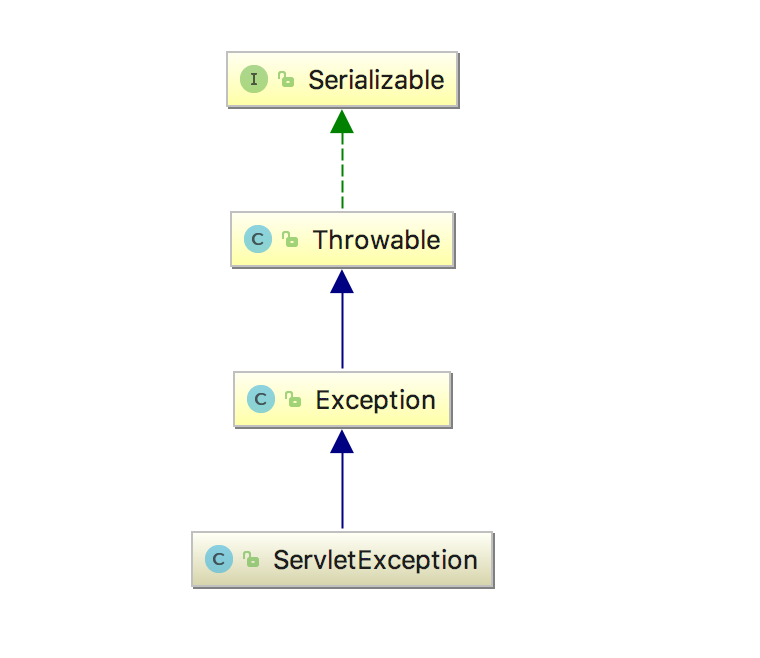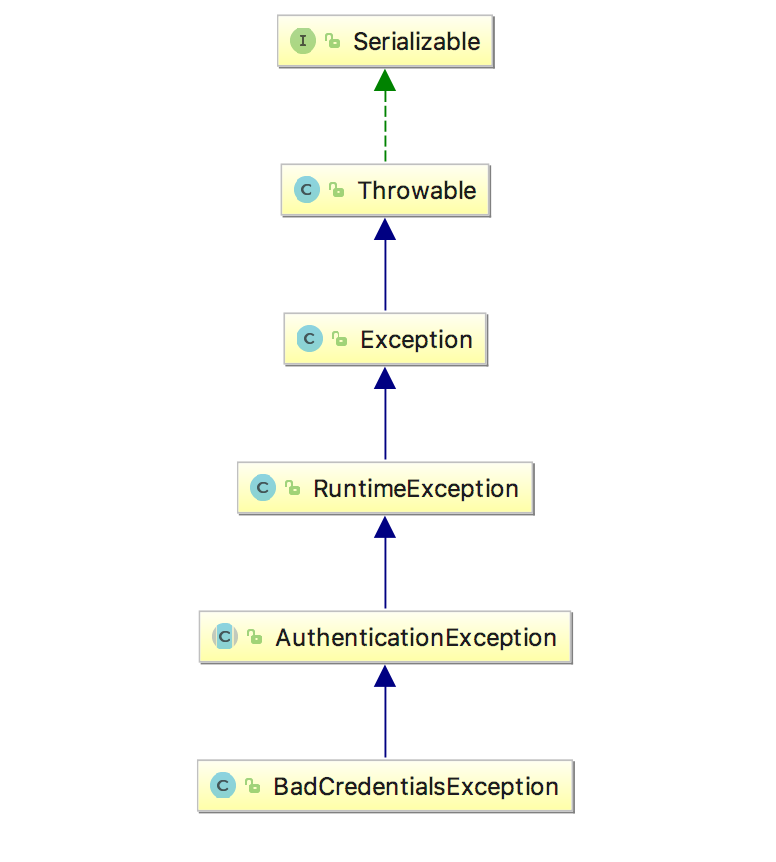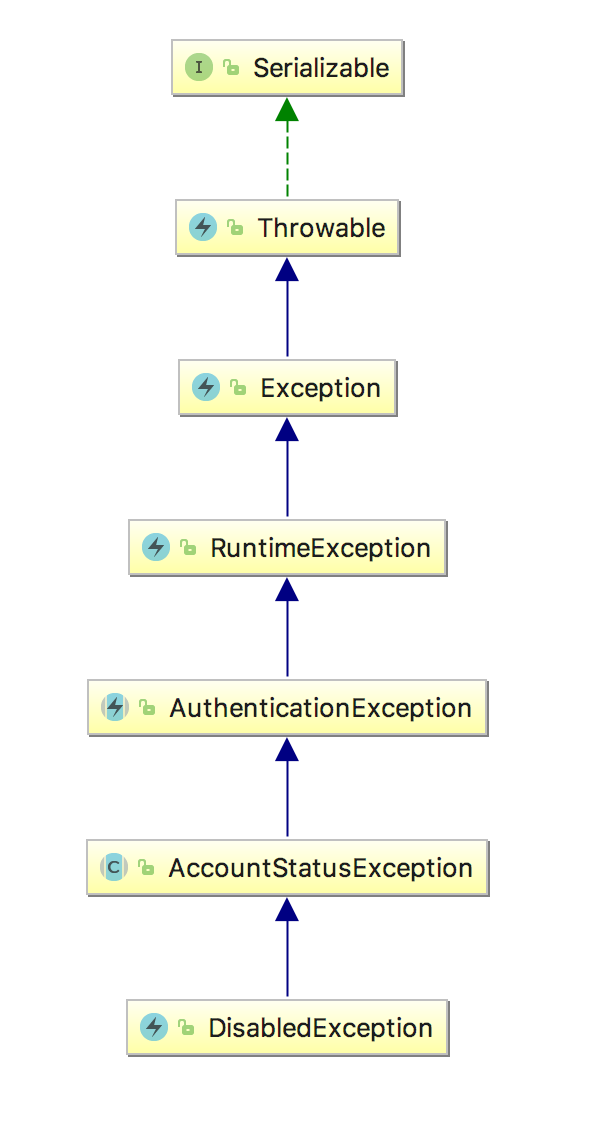Spring Security中異常上拋機制及對於轉型處理的一些感悟
阿新 • • 發佈:2018-11-24
在使用Spring Security的過程中,我們會發現框架內部按照錯誤及問題出現的場景,劃分出了許許多多的異常,但是在業務呼叫時一般都會向外拋一個統一的異常出來,為什麼要這樣做呢,以及對於丟擲來的異常,我們又該如何分場景進行差異化的處理呢,今天來跟我一起看看吧。
一個登陸場景下的外層程式碼
@PostMapping("/login")
public void login(@NotBlank String username,
@NotBlank String password, HttpServletRequest request) {
try {
request.login(username, password);
System.out.println("login success");
} catch (ServletException authenticationFailed) {
System.out.println("a big exception authenticationFailed");
}
}
request.login(username,password)跳入到了HttpServlet3RequestFactory類中,點選去發現login方法只是統一向外丟擲了一個ServletException異常。
public void login(String username, String password) throws ServletException {
if (this.isAuthenticated()) {
throw new ServletException("Cannot perform login for '" + username + "' already authenticated as '" + this.getRemoteUser() + "'");
} else {
AuthenticationManager authManager = HttpServlet3RequestFactory.this.authenticationManager;
if (authManager == null) {
HttpServlet3RequestFactory.this.logger.debug("authenticationManager is null, so allowing original HttpServletRequest to handle login");
super.login(username, password);
} else {
Authentication authentication;
try {
authentication = authManager.authenticate(new UsernamePasswordAuthenticationToken(username, password));
} catch (AuthenticationException var6) {
SecurityContextHolder.clearContext();
throw new ServletException(var6.getMessage(), var6);
}
SecurityContextHolder.getContext().setAuthentication(authentication);
}
}
} 但是在ProviderManager類中的public Authentication authenticate(Authentication authentication) throws AuthenticationException {}
public Authentication authenticate(Authentication authentication) throws AuthenticationException {
Class<? extends Authentication> toTest = authentication.getClass();
AuthenticationException lastException = null;
Authentication result = null;
boolean debug = logger.isDebugEnabled();
Iterator var6 = this.getProviders().iterator();
while(var6.hasNext()) {
AuthenticationProvider provider = (AuthenticationProvider)var6.next();
if (provider.supports(toTest)) {
if (debug) {
logger.debug("Authentication attempt using " + provider.getClass().getName());
}
try {
result = provider.authenticate(authentication);
if (result != null) {
this.copyDetails(authentication, result);
break;
}
} catch (AccountStatusException var11) {
this.prepareException(var11, authentication);
throw var11;
} catch (InternalAuthenticationServiceException var12) {
this.prepareException(var12, authentication);
throw var12;
} catch (AuthenticationException var13) {
lastException = var13;
}
}
}
if (result == null && this.parent != null) {
try {
result = this.parent.authenticate(authentication);
} catch (ProviderNotFoundException var9) {
;
} catch (AuthenticationException var10) {
lastException = var10;
}
}
if (result != null) {
if (this.eraseCredentialsAfterAuthentication && result instanceof CredentialsContainer) {
((CredentialsContainer)result).eraseCredentials();
}
this.eventPublisher.publishAuthenticationSuccess(result);
return result;
} else {
if (lastException == null) {
lastException = new ProviderNotFoundException(this.messages.getMessage("ProviderManager.providerNotFound", new Object[]{toTest.getName()}, "No AuthenticationProvider found for {0}"));
}
this.prepareException((AuthenticationException)lastException, authentication);
throw lastException;
}
}
這裡就涉及到了多型的知識點,異常的多型。如子異常AccountStatusException都可以向上轉型為統一的驗證異常AuthenticationException。
在設計之初的時候,驗證類統一的父級異常是AuthenticationException。然後根據業務需求向下拓展出了很多個場景性質的異常,可能有十個、一百個、一千個。
但是這些具體的場景異常都是從AuthenticationException延伸出來的。在這個驗證登陸的方法中,會驗證各種場景下登陸是否合法,就有可能出現很多的異常場景,諸如:
- 密碼不正確 BadCredentialsException
- 賬號是否被鎖定 LockedException
- 賬號是否被禁用 DisabledException
- 賬號是否在有效期內 AccountExpiredException
- 密碼失效 CredentialsExpiredException
兩個場景下的異常類關係圖譜
ServletException
 ServletException可以向上轉型為Throwable
ServletException可以向上轉型為Throwable
BadCredentialsException,密碼錯誤
 BadCredentialsException可以向上轉型為Throwable
BadCredentialsException可以向上轉型為Throwable
賬號被禁用,DisabledException
 DisabledException可以向上轉型為Throwable
怎麼轉過去的?
DisabledException可以向上轉型為Throwable
怎麼轉過去的?
public void login(String username, String password) throws ServletException{
...
catch (AuthenticationException loginFailed) {
SecurityContextHolder.clearContext();
throw new ServletException(loginFailed.getMessage(), loginFailed);
}
}
// 在捕獲到異常之後會構建一個ServletException並將AuthenticationException統一的包裝進去,比如說內部報了BadCredentialsException,那麼在這裡就會向上轉型為Throwable
public ServletException(String message, Throwable rootCause) {
super(message, rootCause);
}
// 在Throwable類中會將最下面冒出來的異常傳給cause,getRootCause就能獲得異常的具體原因
public Throwable(String message, Throwable cause) {
fillInStackTrace();
detailMessage = message;
this.cause = cause;
}
// Throwable向下轉型BadCredentialsException
if (throwable instanceof BadCredentialsException)
